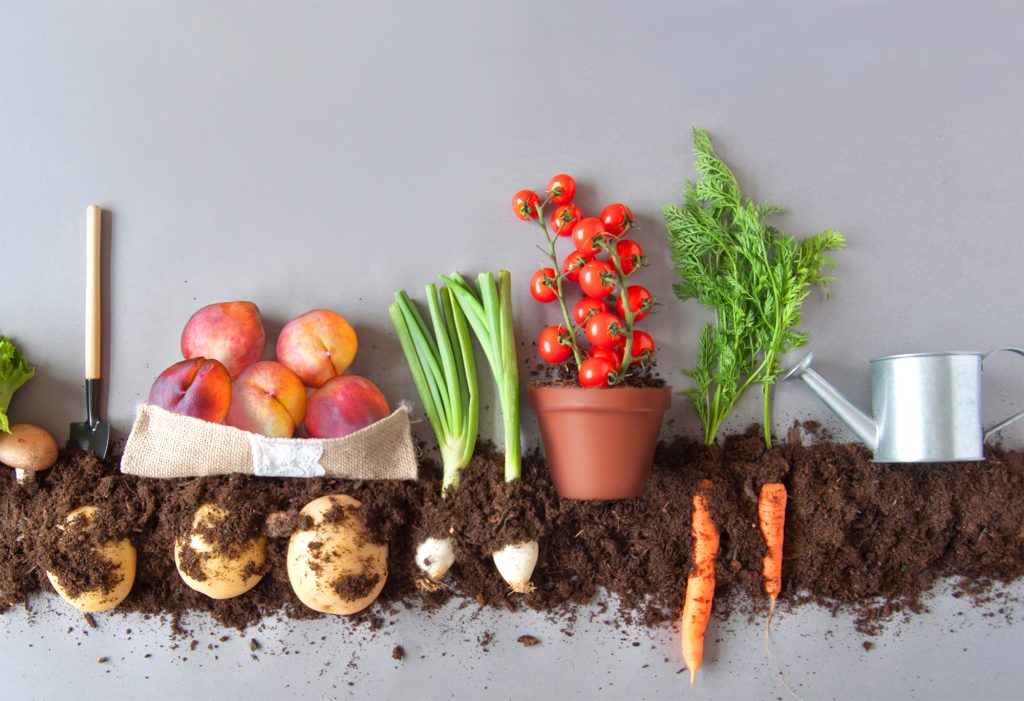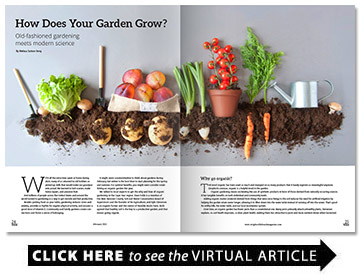How Does Your Garden Grow?
Old-fashioned gardening meets modern science
BY Melissa Sutton-Seng

With all the extra time spent at home during 2020, many of us returned to old hobbies or picked up skills that would make our grandparents proud. We learned to knit scarves, make home repairs, and preserve fruit.
And millions of people across the United States and around the world turned to gardening as a way to get outside and feel productive.
Besides putting food on your table, gardening reduces stress and anxiety, provides a rhythm for regular physical activity, and ensures a good dose of vitamin D. Community and family gardens create connections and foster a sense of belonging.
It might seem counterintuitive to think about gardens during February, but winter is the best time to start planning for the spring and summer. For optimal benefits, you might even consider establishing an organic garden this year.
We talked to local experts to get the why and how of organic gardening in the Cape Fear region. Evan Folds is a member of the New Hanover County Soil and Water Conservation Board of Supervisors and the founder of Be Agriculture, and Kyle Stenersen is an organic farmer and the owner of Humble Roots Farm. Both agreed that healthy soil is the key to a productive garden, and that means going organic.
Why go organic?
The word organic has been used so much and stamped on so many products that it barely registers as meaningful anymore. Despite its overuse, organic is a helpful word in the garden.
Organic gardening means eschewing the use of synthetic products in favor of those derived from naturally occurring sources. It has tangible benefits on both individual and community levels.
Adding organic matter (material derived from things that were once living) to the soil reduces the need for artificial irrigation by helping the garden retain water longer, allowing it to filter down into the water table instead of running off into the sewer. That’s good for utility bills, the water table, and our local stormwater system.
Over time, an organic garden has fewer pests than a conventional one. Many pests primarily attack unhealthy plants, Stenersen explains. As soil health improves, so does plant health, making them less attractive to pests and more nutrient-dense when harvested.
Grow organic.
Whether you’re an old pro or a total novice, incorporating organic gardening principles can increase yields and improve soil quality in addition to benefiting the larger community and local ecosystem.
Converting a conventional garden to an organic garden:
Apply biochar to absorb toxins if that’s a concern.
Add good soil if minerals and nutrients are already depleted.
Add organic matter.
Switch from synthetic to organic inputs (fertilizers, etc.).
Quick facts:
On 1 acre of land, a 1 percent increase in organic matter can help retain 25,000 gallons of water yearly.
A 1 percent increase in organic matter can reduce the need for fertilizer by 40 percent.
All veggies grow in the top 8-10 inches of soil.
Scientists estimate there are more microorganisms in a tablespoon of soil than there are people on the planet!
It’s alive! The soil, that is.
The alternative to synthetics is to add life to the soil itself; that is organic gardening.
Organic gardening isn’t new. In many ways, it’s a return to the methods our great-grandparents used. Now, however, we have access to the science explaining why those age-old techniques worked.
Plants are nourished by the soil they grow in. We now know that, much like our own bodies, soil has a microbiome.
A tablespoon of healthy soil has billions of invisible microorganisms, all working to support the life of larger organisms like the plants in a garden. In the same way that eating yogurt adds good bacteria to your gut and makes you healthier, nurturing the microbes in your soil makes your garden healthier.
Similarly, just like a round of strong antibiotics can wreck your digestive system, pesticides and herbicides kill soil microbes and damage the microbiome plants depend on for nourishment.
What’s so bad about synthetics?
Essentially, synthetic fertilizers and pesticides used in conventional gardening are chemical compounds not found in nature.
“Nature doesn’t know what it is, so nature doesn’t know what to do with it,” Folds says.
Synthetics usually produce impressive results almost instantly but a decline in soil quality over time, Stenersen says, leading to ever-increasing demand for fertilizer and ever-decreasing soil quality. It’s a vicious downward spiral.
In addition to the negative effects on soil, synthetic fertilizers adversely impact the local water system. Rainwater and irrigation runoff put high levels of nutrients into local waterways, causing certain organisms to grow very quickly, which in turn kills others.
A highly visible example is the green algae blooms often seen on the surface of Greenfield Lake in Wilmington. Algal blooms deprive the aquatic environment of oxygen, which leads to mass die-off of other species, like the fish in the lake.
Synthetic pesticides tend to kill beneficial organisms, as well as detrimental ones. This leaves both garden soil and areas touched by runoff susceptible to subsequent invasion of harmful species that would normally have been suppressed by native, beneficial organisms.
Synthetic pesticides also kill many pollinators, which are crucial not only to gardens but to the larger ecosystem, not to mention honey production.
Starting an organic garden from scratch.
With over a decade of experience, Stenersen knows a thing or two about organic gardening. After several years of requests from farmers market customers, he designed an organic gardening course to teach people how to grow their own food without the use of synthetic additives.
Growing food organically is important.
“You are what you eat,” he says. “And you are what you eat eats.”
In other words, what our plants are fed is what we’re feeding ourselves.
His full course is available via the Humble Roots Farm website, but Stenersen outlined the basics for us.
The Plan
Find the sunshine. A successful garden needs at least six hours of direct sunlight each day. Plants that don’t get enough sun tend to grow tall rather than full and to yield small produce. Take the time to observe where the sun shines in your yard over the course of a day and adjust your plot location accordingly.
Clear the ground. Cover the garden area with an impermeable material and leave it for several weeks. Grass and weeds will die from lack of sun and water, and can be raked away as debris. The longer the ground is covered, the less weed pulling will be necessary. Ground prepared just before growing season begins can be cleared the hard way, with a rototiller or shovel. Whichever method is used, the goal is to remove all vegetation, including the roots, to give the garden plants room to grow.
Create garden beds. Stenersen recommends making 30-inch wide beds with 18-inch wide pathways between them. This uses space efficiently while allowing enough room to walk between beds and tend the plants.
Decide what to plant. Gardeners should think about what and how much their family enjoys eating, taking into consideration the size of the garden and what can be expected to grow well. If there’s not much sun, focus on leafy green veggies and herbs. For beginning gardeners or gardening with children, start with easy to grow plants like sugar snap peas, peppers, cucumbers and squash.
The Pillars
Soil health and nutrition. In coastal regions, soil tends to be sandy. It drains very quickly and holds less water and fewer nutrients than denser soils like clay. Topsoil can be added to very sandy soil to improve water and nutrient retention. Organic matter should make up between 3 percent – 8 percent of the soil. Compost or manure can be added to soil that is low in organic matter. A soil test can determine what amendments are needed. Well-balanced soil is available for purchase for raised beds or to replace soil that is contaminated or extremely low in quality. Local sources are preferable because they contain microorganisms native to the area, and producers intentionally harvest them to nurture a healthy microbiome suitable for local growing conditions.
Water and irrigation. Vegetables are up to 90 percent water, so it’s important to ensure they get enough of it. Soil rich in organic matter retains more rainwater, but irrigation is necessary to get through dry spells. Gardeners can choose overhead or drip irrigation, and each has advantages and drawbacks. For example, overhead sprinklers mimic rain and are in some ways faster and easier, whereas drip systems are more efficient and more economical if you’re paying for water.
Seeds and plants. Many gardeners start seeds indoors or in a greenhouse. This is economical and lets you get your hands in the soil while it’s still cold outside. Purchasing transplants is an option for those who wait a bit too long or don’t have space to start seeds inside, but avoid root-bound seedlings and only buy healthy, in-season plants. A few crops, like baby greens and carrots, don’t transplant well and should be direct seeded. Research the best practices for success in whichever combination of planting methods is chosen.
Protection. Guard against weeds by using a fabric cover or organic mulch to starve them of sunlight. When weeds do pop up, there are several methods for eliminating them without the use of herbicides, including flame weeding (yes, with a garden torch!) or careful application of vinegar. A healthy ecosystem with a wide variety of plants, including flowering perennials, is the best protection against harmful insects looking to snack on veggies. Healthy soil and a diversity of plant life attract predatory insects that will keep pest populations under control. If there is an infestation, choose a naturally derived treatment based on the type of insect.

